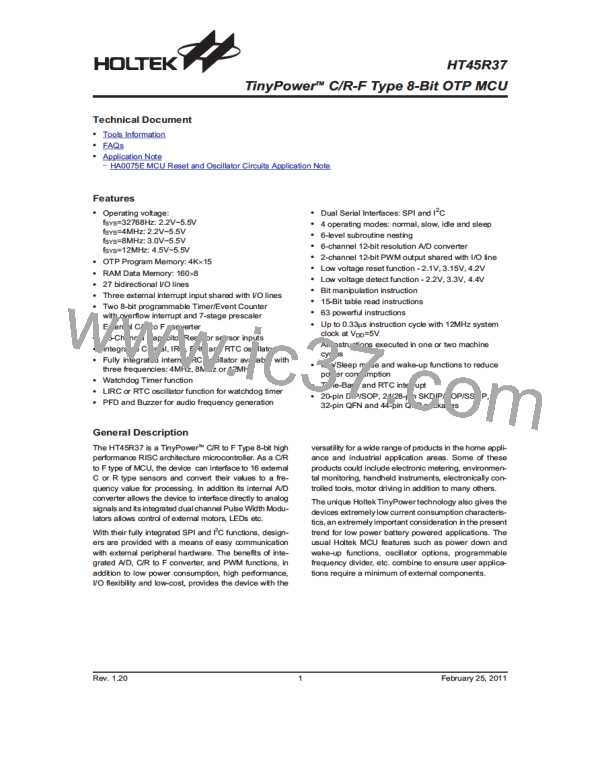HT45R37
Fast Wake-Up
gram can therefore determine the presence of a low
voltage condition.
To minimise power consumption the device can enter
the SLEEP or IDLE Mode, where the clock source to the
device will be stopped. However when the device is
woken up again, it can take a considerable time for the
original system oscillator to restart, stabilise and allow
normal operation to resume. To ensure the device is up
and running as fast as possible a Fast Wake-Up function
is provided, which allows fSUB, namely either the RTC or
LIRC oscillator, to act as a temporary clock to first drive
the system until the original system oscillator has stabi-
lised. As the clock source for the Fast Wake-Up function
is the Watchdog Timer clock, the Watchdog Timer must
be enabled for this function to operate. If the Watchdog
Timer is not enabled then the Fast Start-up function can-
not be used. The Fast Wake-Up enable/disable function
is controlled using the configuration option.
After power-on, or after a reset, the LVD will be switched
off by clearing the LVDC bit in the RTCC register to zero.
Note that if the LVD is enabled there will be some power
consumption associated with its internal circuitry, how-
ever, by clearing the LVDC bit to zero the power can be
minimised. It is important not to confuse the LVD with
the LVR function. In the LVR function an automatic reset
will be generated by the microcontroller, whereas in the
LVD function only the LVDO bit will be affected with no
influence on other microcontroller functions.
There are a range of voltage values, selected using a
configuration option, which can be chosen to activate
the LVD.
Watchdog Timer
If the Crystal oscillator is selected as the NORMAL
Mode system clock, and if the Fast Wake-Up function is
enabled, then it will take one to two tSUB clock cycles of
the LIRC or RTC oscillator for the system to wake-up.
The system will then initially run under the fSUB clock
source until 1024 Crystal clock cycles have elapsed, at
which point the HTO flag will switch high and the system
will switch over to operating from the Crystal oscillator.
The Watchdog Timer is provided to prevent program
malfunctions or sequences from jumping to unknown lo-
cations, due to certain uncontrollable external events
such as electrical noise. It operates by providing a de-
vice reset when the Watchdog Timer counter overflows.
Watchdog Timer Operation
The Watchdog Timer clock source is provided by the in-
ternal clock, fS, which is in turn supplied by one of two
sources selected by configuration option: fSUB or fSYS/4.
Note that if the Watchdog Timer configuration option
has been disabled, then any instruction relating to its op-
eration will result in no operation.
If the ERC or HIRC oscillators or LIRC oscillator is used
as the system oscillator then it will take 1~2 clock cycles
of the ERC, HIRC or LIRC to wake up the system from
the SLEEP or IDLE Mode.
Note that if the Watchdog Timer is disabled, which
means that the RTC and LIRC are all both off, then there
will be no Fast Wake-Up function available when the de-
vice wakes-up from the SLEEP Mode.
Most of the Watchdog Timer options, such as en-
able/disable, Watchdog Timer clock source and clear in-
struction type are selected using configuration options.
In addition to a configuration option to enable the Watch-
dog Timer, there are four bits, WDTEN3~ WDTEN0, in
the MISC register to offer an additional enable control of
the Watchdog Timer. These bits must be set to a specific
value of 1010 to disable the Watchdog Timer. Any other
values for these bits will keep the Watchdog Timer en-
abled. After power on these bits will have the disabled
value of 1010.
Low Voltage Detector - LVD
The Low Voltage Detect internal function provides a
means for the user to monitor when the power supply
voltage falls below a certain fixed level as specified in
the DC characteristics.
LVD Operation
The LVD function must be first enabled via a
configuration option after which bits 3 and 5 of the RTCC
register are used to control the overall function of the
LVD. Bit 3 is the enable/disable control bit and is known
as LVDC, when set low the overall function of the LVD
will be disabled. Bit 5 is the LVD detector output bit and
is known as LVDO. Under normal operation, and when
the power supply voltage is above the specified VLVD
value in the DC characteristic section, the LVDO bit will
remain at a zero value. If the power supply voltage
should fall below this VLVD value then the LVDO bit will
change to a high value indicating a low voltage condi-
tion. Note that the LVDO bit is a read-only bit. By polling
the LVDO bit in the RTCC register, the application pro-
One of the WDT clock sources is the internal fSUB, which
can be sourced from either the 32K_INT internal oscilla-
tor or the 32768Hz oscillator. The 32K_INT internal os-
cillator has an approximate period of 31.2ms at a supply
voltage of 5V. However, it should be noted that this
specified internal clock period can vary with VDD, tem-
perature and process variations. The 32768Hz oscillator
is supplied by an external 32768Hz crystal. The other
Watchdog Timer clock source option is the fSYS/4 clock.
Whether the Watchdog Timer clock source is its own in-
ternal 32K_INT, the 32768Hz oscillator or fSYS/4, it is di-
vided by 213~216, using configuration option to obtain the
required Watchdog Timer time-out period. The max time
out period is when the 216 option is selected. This
Rev. 1.20
67
February 25, 2011

 HOLTEK [ HOLTEK SEMICONDUCTOR INC ]
HOLTEK [ HOLTEK SEMICONDUCTOR INC ]